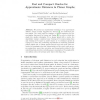Free Online Productivity Tools
i2Speak
i2Symbol
i2OCR
iTex2Img
iWeb2Print
iWeb2Shot
i2Type
iPdf2Split
iPdf2Merge
i2Bopomofo
i2Arabic
i2Style
i2Image
i2PDF
iLatex2Rtf
Sci2ools
ESA
2007
Springer
2007
Springer
Fast and Compact Oracles for Approximate Distances in Planar Graphs
We present an experimental evaluation of an approximate distance oracle recently suggested by Thorup [1] for undirected planar graphs. The oracle uses the existence of graph separators for planar graphs, discovered by Lipton and Tarjan [2], in order to divide the graph into smaller subgraphs. For a planar graph with n nodes, the algorithmic variant considered uses O(n(log n)3 / ) preprocessing time and O(n(log n)2 / ) space to answer factor (1 + ) distance queries in O((log n)2 / ) time. By performing experiments on randomly generated planar graphs and on planar graphs derived from real world road networks, we investigate some key characteristics of the oracle, such as preprocessing time, query time, precision, and characteristics related to the underlying data structure, including space consumption. For graphs with one million nodes, the average query time is less than 20μs.
| Added | 07 Jun 2010 |
| Updated | 07 Jun 2010 |
| Type | Conference |
| Year | 2007 |
| Where | ESA |
| Authors | Laurent Flindt Muller, Martin Zachariasen |
Comments (0)

